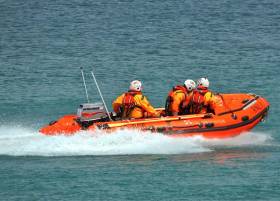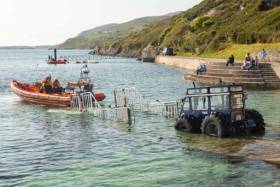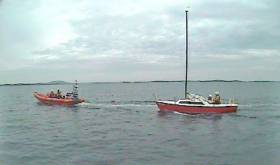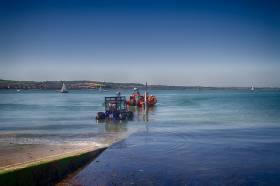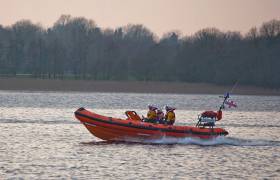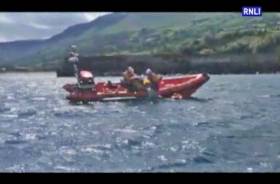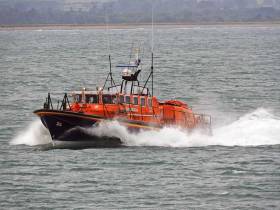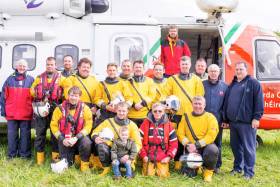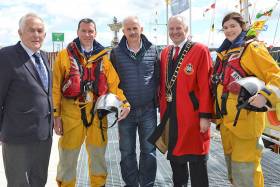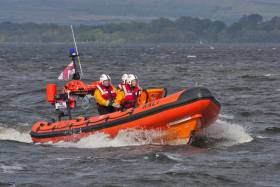Displaying items by tag: Lifeboats
#RNLI - Wicklow RNLI’s inshore lifeboat was launched at 1.48pm on Saturday afternoon (24 June) after a member of the public reported a windsurfer in difficulty off Silver Strand, three miles south of Wicklow Harbour.
The lifeboat with three crew — helm Graham Fitzgerald, Vinne Mulvilhill and Connie O’Gara — was alongside the casualty seven minutes after launching. A local angling boat had also stood by the windsurfer until the lifeboat arrived.
The casualty was taken onto the lifeboat and assessed. He did not require any medical assistance and was landed safely back on Silver Strand a short time later.
Speaking after the callout, Wicklow RNLI lifeboat helm Graham Fitzgerald said: “We located the windsurfer about half a mile offshore. He had left the beach earlier but the wind dropped and he was unable to get back ashore.”
Two Medevacs For Clifden Lifeboat Since Friday
#RNLI - Clifden RNLI has carried out two medical evacuations from the island of Inishbofin off Connemara since Friday (23 June).
The pagers first sounded at 11.15am on Friday in response to a call for the medevac of an elderly woman in need of hospital treatment.
Clifden's D Class inshore lifeboat and crew were already on the water in Clifden Bay carrying out a scheduled exercise when they were called to transfer to the Atlantic 85, helmed by Joe Acton, that arrived at the island before the Irish Coast Guard helicopter Rescue 118, which was also tasked.
Lifeboat crew member Sinead Pryce assisted the casualty, and the lifeboat and helicopter worked together to ensure a seamless transfer.
The following morning (Saturday 24 June), pagers once again sounded shortly after 7.15am after a woman on Inishbofin had become suddenly unwell.
The all-weather boat Fisherman’s Friend was requested to respond and a crew was assembled including coxswain Alan Pryce, mechanic Robert King, navigator Owen Hayes and crew Brian Ward and Neil Gallery.
The casualty was transferred to the all-weather boat by the crew and island nurse and taken to Cleggan Pier where an ambulance was waiting.
Speaking following the callouts, Clifden RNLI lifeboat operations manager John Brittain said: “It has been a busy summer week for the Clifden lifeboats with three launches taking place involving our different boats in different scenarios.
“I want to thank the crew for responding to their pagers promptly in these cases so that we can continue to carry out this vital service in our local community.”
Clifden, Union Hall Lifeboats Launch To Yachts In Difficulty
#RNLI - Clifden RNLI prepared for launch at 7.16pm on Tuesday evening (20 June) to assist a yacht gone aground in the Clifden Bay area.
Helm David Barry, along with volunteer crew Ian Shanahan, Brian Ward and Owen Hayes on the Atlantic 85 inshore lifeboat, quickly located the 23ft yacht stranded on a rocky piece of shoreline.
The lone sailor on board was uninjured, and after communication with the lifeboat crew, it was agreed to tow the yacht from its location.
Clifden’s all-weather lifeboat and the Rescue 118 helicopter from Sligo were also requested to assist, but both were stood down when the yacht was successfully under tow.
Speaking following the callout, Barry said: “We returned the sailor and his yacht to a mooring in Clifden Bay and were glad to have been able to respond so quickly to a vessel in need of assistance.”
Meanwhile in West Cork, Union Hall RNLI were requested at 8.32pm to provide assistance to a 21ft yacht with two people on board, seven-and-a-half miles south of Adam Island at the entrance to Glandore Harbour.
The Union Hall inshore lifeboat Margaret Bench of Solihull launched within seven minutes and headed to the yacht, where sea conditions were calm but the yacht had encountered a squall, which resulted in the loss of a sail and instruments.
The lifeboat volunteers made contact with the two people on board, ensured there was no injuries, attached a tow line and towed the yacht back to the safety of Union Hall Pier.
Speaking after the callout, Union Hall RNLI lifeboat operations manager John Kelleher said: “The crew of the yacht made the right decision to contact the coastguard sooner rather than later.
“Always carry a means of communication, be it VHF or mobile phone. It is very important, especially at nighttime.”
Fine Weather Means Busy Weekend For Skerries Lifeboat
#RNLI - Skerries RNLI volunteers were tasked on three separate occasions last weekend with the pagers sounding once on Saturday (17 June) and twice on Sunday (18 June).
Shortly after 3pm on Sunday afternoon, Dublin Coast Guard received reports that a number of people were in the water having been cut off by the rising tide.
Skerries RNLI were tasked and the volunteers launched their Atlantic 85 inshore lifeboat with Conor Walsh at the helm and crewed by Stephen Crowley, Steven Johnston and Peter Kennedy.
The lifeboat was on scene within a matter of minutes and immediately located a man and woman struggling to make their way ashore.
The man was chest deep in water while the woman was holding on to his shoulders and kicking her legs to stay afloat.
They were assisted into the lifeboat where the crew began first aid assessments and protected them from the elements.
Once it was established that all others in their group had made it safely ashore, the lifeboat brought the man and woman back to the station where they were further assessed.
They were cold from having been in the water for a length of time, but were otherwise unharmed. After a period of monitoring, they left the station safe and well.
The previous afternoon, Skerries RNLI were tasked by Dublin Coast guard around 4.30pm after a member of the public reported a child in an inflatable boat drifting out to sea near Gormanston.
The lifeboat was launched and proceeded to make their way to the location given. However, while they were en route they received an update that some swimmers in the area had managed to help the child ashore and the lifeboat was stood down.
Late on Sunday evening, the pagers sounded for the third time in two days, after a call was received by Dublin Coast Guard informing them that a man in a distressed state had entered the water in Rush.
However, before the lifeboat could be put to sea our volunteers were stood down as the man had been safely assisted ashore.
Speaking about the callouts, Skerries RNLI lifeboat press officer Gerry Canning said: “We’ve been enjoying some fantastic weather lately. This means we may have more people making the most of our coastline.
“We’d encourage anyone visiting the area to check the local tides and always be aware of their surroundings and the dangers they might present.”
Lough Ree Lifeboat Assists Three After Late-Night Breakdown
#RNLI - Lough Ree RNLI assisted one man and two women after their boat broke down at the north end of Lough Ree last night (Monday 19 June).
The volunteer lifeboat crew was alerted by the Irish Coast Guard in Malin Head at 11.40pm to assist the speed boat located near Inch McDermott and Ferinch Islands.
Deputy launching authority Matt Harte with shore crew Eamon Flynn and Denis Buckley prepared inshore lifeboat The Eric Rowse for launch with helm Stan Bradbury and crew Kieran Scullion and Tony Diskin on board.
Weather conditions at the time were described as breezy with a Force 2-3 wind with heavy cloud cover, making it challenging for the lifeboat crew to locate the casualty vessel.
Upon arriving near Inch McDermott, the lifeboat crew lit two illumination flares to enable them to locate the speed boat. The three onboard were able to light a small fire to further enable the lifeboat crew to locate them on a rocky outcrop to the western side of Ferinch Island.
Having ensured everyone onboard was uninjured and inspected the boat for damage, a tow line was secured and man joined the crew on the inshore lifeboat to assist with navigation through a small channel to a nearby harbour on the shore.
Speaking following the callout, Stan Bradbury said: “We were delighted to be of assistance last night and would remind anyone planning a trip on the lake to always carry a means of calling or signalling for help. This becomes even more important at night or when visibility is reduced.”
#RNLI - The volunteer lifeboat crew with Red Bay RNLI rescued two kayakers yesterday afternoon (Saturday 17 June) after their vessel capsized near Waterfoot in Co Antrim.
The alarm was raised at 3.33pm when a member of the public heard two men shouting for help after their kayak upturned and they were blown out to sea.
The Red Bay inshore lifeboat was immediately requested to launch by Belfast Coastguard and the lifeboat crew were quickly on scene.
As they arrived, the lifeboat crew saw the two men in the water clinging to an upturned kayak. They immediately recovered them onto the lifeboat and brought them safely ashore.
Commenting on the callout, Red Bay RNLI helm Paddy McLaughlin said: “It was a beautiful day on the Antrim coast and many people took to the water. These men were very lucky their calls for help were heard and that the lifeboat crew were on scene so quickly.
“We would advise everyone enjoying the water during the warm weather to take all necessary safety precautions including wearing a suitable flotation device and having a means of calling for help.”
Wicklow Lifeboat Assists Whelk Fishing Vessel
#RNLI - Wicklow RNLI's all-weather lifeboat launched at 2.50pm yesterday afternoon (Wednesday 14 June) to assist the crew of a whelk fishing vessel off the Wicklow coast.
The skipper contacted Wicklow Head Coast Guard by VHF radio for assistance after a rope got caught in the trawler’s propeller.
The lifeboat, under the command of senior deputy second coxswain Tom McAulay and a volunteer crew, was alongside the casualty 40 minutes after launching at a point over 12 miles north of Wicklow Port near the Codling Bank.
While the lifeboat was en route, the three fishermen reported that they managed to clear the rope from the propeller and were able to get underway.
McAulay carried out an assessment and the lifeboat escorted the trawler while it crossed the Codling Bank.
Once satisfied that the obstruction was clear and the fishing vessel was capable of resuming its passage safely back to Wicklow Harbour, the lifeboat returned to station.
The crew on the call out were McAuley, mechanic Brendan Copeland, Terry Sillery, Carol Flahive, Lisa O’Leary, Paul Sillery and Dean Mulvihill.
#RNLI - Volunteers from Lough Ree RNLI had a successful training exercise with the Sligo-based Irish Coast Guard helicopter Rescue 118 yesterday (Sunday 11 June).
The lifeboat and helicopter crews came together for a joint training exercise at Lough Ree Yacht Club amid changeable weather conditions, with winds Force 4-6 and frequent rain showers blowing through.
On arrival, Rescue 118 landed at the yacht club grounds where the pilot and crew briefed the Lough Ree RNLI volunteers, after which they invited the RNLI crew, family members and yacht club members to have a tour of the helicopter.
The exercise got underway with the lifeboat crew members being winched between their inshore lifeboat The Eric Rowse and the helicopter. The strong winds enabled easier hovering for the helicopter, and provided the lifeboat crew with an invaluable experience.
Speaking following the exercise, Lough Ree RNLI volunteer deputy press officer Sarah Bradbury said: “Joint training exercises such as today’s allows our crews to develop their skills, work with and share learning experiences with our colleagues in the Irish Coast Guard and most importantly prepare for working effectively with each other when the time comes and we need to help someone in need.”
The exercise came days after a busy bank holiday weekend for the Lough Ree lifeboat, as previously reported on Afloat.ie.
Clogherhead RNLI Launches €150K Lifeboat Appeal
#RNLI - Clogherhead RNLI in Co Louth officially launched the station’s €150,000 Shannon lifeboat appeal on the final day of the Drogheda maritime festival yesterday (Sunday 11 June).
The total cost of Clogherhead’s new Shannon class all-weather lifeboat will be in the region of €2.5 million, the majority of which will be provided through an Irish legacy.
However, the lifeboat station must raise €150,000 towards the cost of the project through a community appeal before the lifeboat is due to go on service in 2019.
The current Clogherhead lifeboat, Doris Bleasdale, is a Mersey class that can reach a top speed of 15 knots.
In the last five years, the lifeboat crew in Clogherhead have launched their lifeboat 58 times and brought 60 people to safety.
With a Shannon class lifeboat, designed by Derry man Peter Eyre, those launches will be even faster with its top speed of 25 knots, and improved range and manoeuvrability thanks to its waterjet propulsion, which also allows the vessel to operate in shallow waters and be intentionally beached.
The official launch took place in the presence of the Mayor of Drogheda Oliver Tully and the Drogheda Harbour Master Captain Martin Donnelly on the new pier for visiting yachts at Drogheda Port, which was itself launched at the weekend during the Irish Maritime Festival.
Speaking at the launch, Drogheda Mayor Oliver Tully paid tribute to the Clogherhead lifeboat crew.
“When we hear of the RNLI going to sea we think of Clogherhead and we think of the all the lives you have saved and your predecessors before you. I would like to thank you for the tremendous work that you do. It is the Clogherhead lifeboat but is supported by everyone in the surrounding area.”
The Mayor also hailed lifeboat mechanic Padraig Rath for keeping the current lifeboat in pristine condition for 24 years.
Coxswain Tomas Whelehan added: “We are delighted that this day is finally here and we can announce the news of a Shannon class lifeboat for the east coast. We have been overwhelmed with the goodwill of people and offers of support. This new lifeboat will represent everyone in our communities as well as those who visit our shores for work or pleasure.
“Our lifeboat crew launch in all conditions at any time of night or day to bring loved ones home. The least we can do is give them the very best in lifeboat technology. Not all callouts are rescues and sometimes there is tragedy but whatever the call, our crews are always ready to answer it and our lifeboat always ready to be launched.”
For further details of how to get involved with the Clogherhead RNLI Shannon project, contact the station at 041 982 2600 and follow the Facebook page for updates.
#RNLI - Lough Derg RNLI rescued three people from two grounded yachts in two separate callouts on Sunday (4 June).
At 11.22am, as the lifeboat crew were returning to station following morning exercise, they were requested by Valentia Coast Guard to assist two people on a 22ft yacht aground 1km above Killaloe on the Tipperary shore, at the southern end of Lough Derg.
The lifeboat responded immediately with helm Eleanor Hooker, Darragh Quinn and Barry Morkan on board, and was alongside the casualty vessel at 11.48am. Visibility was good with winds at a westerly Force 3-4.
The yacht was under sail when it was pushed ashore by a severe gust. Both passengers were found to be safe and unharmed and wearing their lifejackets.
The RNLI volunteers checked the boat and when satisfied that it was not holed, set up bridle and tow to take it safely off the rocks.
Before removing the tow, the lifeboat crew made certain that the boat was not taking any water and the rudder was not damaged. The yacht then made way using its outboard motor to its berth at Killaloe.
The second callout came later that afternoon at 3.50pm, following a distress call for assistance on the emergency VHF Channel 16.
Valentia Coast Guard requested Lough Derg RNLI to assist a lone yachtsman whose yacht was aground by Stick Rock, at the northern end of Lough Derg on the Co Clare shore.
At 4.04pm, the lifeboat launched with helm Eleanor Hooker, Ger Egan and Kevin Dooley on board. Winds were south-westerly, visibility was fair to poor with low clouds, rain and frequent squalls.
At 4.38pm, the lifeboat located the yacht at Stick Rock. The yachtsman was safe and unharmed and wearing his lifejacket. An RNLI crew member was transferred to the yacht to assess it for any damage before it was lifted off the rock and back in safe water 11 minutes later.
With the skipper unable to get his inboard engine started, the lifeboat escorted the boat under sail to Cloondavaun Bay, where the RNLI crew took the yacht under tow through the narrow channel to its berth.
Brendan O’Brien, deputy launching authority at Lough Derg RNLI, reminded boat users: “Check weather conditions on the lake before going afloat and to carry up to date charts of the lake.”



























